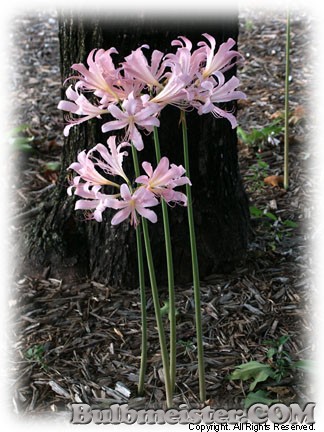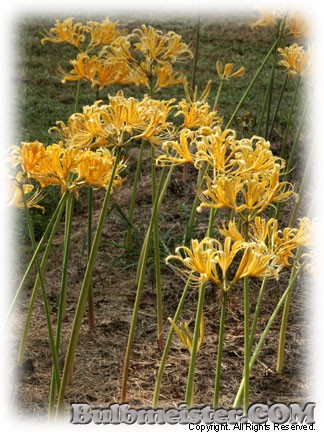06/25/19
Why Buy Surprise Lilies from the Bulbmeister?
Friends,
 If you enjoy growing flower bulbs in your landscape, you are also likely aware that the more unusual the species, the more costly it can be. So, the wise thing to do is to shop around if you want one. The genus, Lycoris, first entered the United States of America in 1854, so surprise lilies, or spider lilies, have been in the U.S. well over 150 years. Yet, this exceptionally beautiful genus is not experiencing widespread cultivation. I believe the reason is due to the fact that it is not suited well to the average gardener and non-gardener. Why? Foliage growth is not associated with bloom, so the foliage is likely mowed or cut down too early in the spring, and no plant will do well if its source of photosynthesis is cut short over and over, year after year. Lycoris foliage needs to be allowed to begin to “die back” or dwindle before cutting it back to the ground, allowing as many resources for the development, growth, and division of the bulb, as well as encouraging floral initiation.
If you enjoy growing flower bulbs in your landscape, you are also likely aware that the more unusual the species, the more costly it can be. So, the wise thing to do is to shop around if you want one. The genus, Lycoris, first entered the United States of America in 1854, so surprise lilies, or spider lilies, have been in the U.S. well over 150 years. Yet, this exceptionally beautiful genus is not experiencing widespread cultivation. I believe the reason is due to the fact that it is not suited well to the average gardener and non-gardener. Why? Foliage growth is not associated with bloom, so the foliage is likely mowed or cut down too early in the spring, and no plant will do well if its source of photosynthesis is cut short over and over, year after year. Lycoris foliage needs to be allowed to begin to “die back” or dwindle before cutting it back to the ground, allowing as many resources for the development, growth, and division of the bulb, as well as encouraging floral initiation.
There are some very easy solutions to avoid improper care of the foliage in the winter and spring.
- If planting in the lawn, plant around the base of deciduous trees or fixed objects like fences and gas meters, so, that when mowing in the spring, the foliage is more easily avoided, even if hiring out the mowing to folks who wouldn’t know better. Curséd weed wackers! Optionally, intermingle with a daffodil planting, because the leaves from afar don’t look that much different than daffodil leaves, and everybody knows not to cut down daffodil foliage until 6 weeks after bloom, right? Right?
- If planting in a flower bed, again they can be intermingled with daffodils, but they can also be planted under small trees or in other locations where foliage is enhanced by nearby plants that bloom during that same period of time.
Why go to the trouble of growing Lycoris, if you consider the above explanations to be extraordinary efforts?
Of how many flower bulb genera do you know that provide a prominent, colorful, hawk moth & hummingbird attracting bloom anywhere from the end of July onward into October (depending on variety/species)? The answer would be very few. Color! Prominent Color! And flower form can go from “spidery” to “trumpety".
I trust you will agree at this point that surprise lily just might be worth the effort it takes to strategically locate it in your landscape, but price can and should always be a consideration when buying plants for the landscape. Lycoris are significanly more expensive than commonly purchased bulbs like Muscari, Narcissus (daffodils) and tulips, but there’s a good reason for that. A Lycoris bulb takes at least THREE years to develop from seed or scale before it becomes blooming size. So, it, therefore, requires more time in the nursery before it can be presented to you as a blooming size bulb. Time is resources! Time is money! I will note here that vendors who sell Lycoris in pots are selling you a product that will not likely bloom for at least two more years. Dormant importers may sell you a flowering size bulb, but the way it was prepared for transport affects its ability to recover and may still lead to a delay of a couple years, if not more. Essentially, the bulbs really need to still keep their roots during dormancy, and the roots would not survive the long process of import into the U.S.
 So, why buy from Bulbmeister, really?
So, why buy from Bulbmeister, really?
All of my Lycoris are field grown, and I dig the bulbs on demand. This allows me to select flowering size bulbs with roots, and it allows you to receive them in as fresh a condition as possible. That’s not all, though! In addition to supplying a superior product compared to any other vendor, my prices are significantly lower than any of the vendors who offer bulbs with roots in pots (remember, with Lycoris, roots are important). My prices are even comparable and can be better than those more commonly available as dormant imports.
So, when purchasing Lycoris from the Bulbmeister, you get:
- Flowering sized
- With roots
- Fresh as a daisy
- Comparably GREAT prices!
Okay, folks! I’m going to say it. But that’s not all! Here’s the most important conclusion for considering this investment.
Lycoris bulbs are perennial and slowly divide (increase). This means you will be buying a flower bulb that gives and keeps on giving! As a matter-of-fact, it is recommended you dig every 7-10 YEARS to divide and spread out the established mass of bulbs. That’s not because you subscribed to an annual Lycoris delivery service! No way! No how! That’s because you loved and respected the unique qualities of Lycoris, so it rewarded you in return, year after year after year for FREE.
Buy from the Bulbmeister! I try my hardest, relying on nobody else but myself, to provide you a quality addition to your landscape.
As of the time of this writing, my already competitive prices are slashed on most Lycoris (surpise, resurrection, hurricane, magic, spider lily)! These special prices will remain in effect through July 4, 2019. I’ve also included Canna and Zephyranthes in this sale. Please do consider the Bulbmeister, and thank you for your time.
I do have to end with a bit of bad news for some. Due to the fact my bulbs are field grown and do have roots, I am unable to serve the state of California.